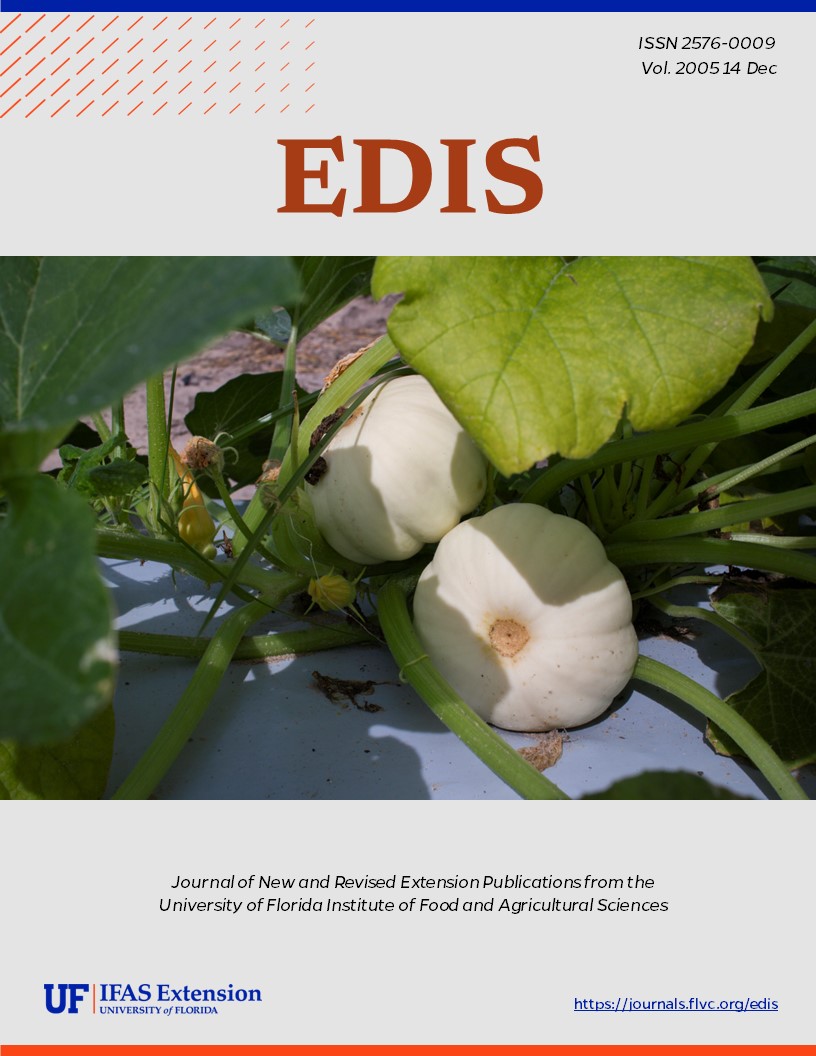Abstract
Adult thrips are small about 0.5 – 1.2 mm long. It is difficult to recognize this thrips with the naked eye, and definitive identification is best accomplished at approximately 40 to 80 x magnification. Eggs are about 0.075 mm long and 0.070 mm wide, and are inserted inside plant tissue. The egg stage lasts for 6-8 days, which is followed by two larval stages (1st and 2nd instars) that last for 6-7 days. The prepupal period is short (~ 24 h) and the pupal period lasts 2-3 days. The larvae are off-white. Also the adults are pale yellow to grayish-white in color with incomplete dark stripes on the dorsal surface where adjacent abdominal segments meet. The life cycle is completed in 14-20 days. The chilli thrips female oviposits 60 to 200 eggs in her life time at the rate of 2-4 eggs per day. This document is ENY-725 (IN638), one of a series of the Entomology and Nematology Department, Florida Cooperative Extension Service, Institute of Food and Agricultural Sciences, University of Florida. First published: November 2005.
References
Amin, B. W. 1979. Leaf fall disease of chilly and pepper in Maharashtra, India. Pans, 25: 131-134. https://doi.org/10.1080/09670877909411686
Amin, P. W., Reddy, D. V. R., Ghanekar, A. M. 1981. Transmission of tomato spotted wilt virus, the causal agent of bud necrosis of peanut, by Scirtothrips dorsalis and Frankliniella schultzei. Plant Disease 65: 663-665. https://doi.org/10.1094/PD-65-663
CABI. 2003. Crop protection compendium: global module. CABI Publishing, Wallingford, UK.
Chang, N. T., Parkeker, B. L., Skinner, M., Lewis, T. 1995. Major pest thrips in Taiwan, pp. 105 - 108, Thrips biology and management: Proceedings of the 1993 International Conference on Thysanoptera. Plenum Press, New York. https://doi.org/10.1007/978-1-4899-1409-5_14
Chu, C. C., M. A. Ciomperlik, Niann-Tai Chang, M. Richards, and T. J. Henneberry. 2005. Developing and evaluating traps for monitoring Scirtothrips dorsalis (Hood) Florida Entomologist (submitted). https://doi.org/10.1653/0015-4040(2006)89[47:DAETFM]2.0.CO;2
EPPO and CABI. 2003. Scirtothrips dorsalis. Data Sheets on Quarantine Pests. In: Quarantine Pests for Europe. 2nd edition. No. 142. CAB International, Wallingford, UK.
FNGLA. (Florida Nursery, Growers and Landscape Association). 2003. The unlucky 13. Report of the Major Nursery Pest & Disease Identification Task Force. Florida Nursery Growers, and Landscape Association, Orlando, Florida, USA. 1 p.
Hoddle, M.S. and L. A. Mound. 2003. The genus Scirtothrips in Australia (Insecta, Thysanoptera, Thripidae). Zootaxa 268: 1-40 https://doi.org/10.11646/zootaxa.268.1.1
Kodomari, S. 1978. Control of yellow tea thrips, Scirtothrips dorsalis Hood, in tea field at east region in Shizuoka Prefecture. Tea Research Journal, No. 48: 46-51. https://doi.org/10.5979/cha.1978.48_46
Meissner, H., A. Lemay, D. Borchert, B. Nietschke, A. Neeley, R. Magarey, M. Ciomperlik, C. Brodel and T. Dobbs. 2005. Evaluation of possible pathways of introduction of Scirtothrips dorsalis Hood (Thysanoptera: Thripidae) from the Caribbean into the continental United States. Center for Plant Health Science and Technology
Mound, L. A., Palmer, J. M. 1981. Identification, distribution and host plants of the pest species of Scirtothrips (Thysanoptera: Thripidae). Bulletin of Entomological Research 71: 467-479. https://doi.org/10.1017/S0007485300008488
Sanap, M. M. and R. N. Nawale. 1987. Chemical control of chilli thrips, Scirtothrips dorsalis Hood (Thysanoptera: Thripidae). Vegetable Science 14(2): 195-199.
Saxena, P., Vijayaraghavan, M. R., Sarbhoy, R. K., Raizada, U. 1996. Pollination and gene flow in chillies with Scirtothrips dorsalis as pollen vectors. Phytomorphology 46: 317-327.
Seal, D. R., M. Ciomperlik, M. L. Richards and W. Klassen. 2005. Distribution of the Chilli thrips, Scirtothrips dorsalis Hood (Thysanoptera: Thripidae), within pepper plants and within pepper fields on St. Vincent. Florida Entomologist (submitted). https://doi.org/10.1653/0015-4040(2006)89[311:DOCTSD]2.0.CO;2
Seal, D. R., M. Ciomperlik, M. L. Richards and W. Klassen. 2005. Comparative effectiveness of chemical insecticides against the chilli thrips, Scirtothrips dorsalis Hood (Thysanoptera: Thripidae), on pepper and their compatibility with natural enemies. Crop Protection (submitted). https://doi.org/10.1016/j.cropro.2005.12.008
Suwanbutr, S., Tongklad, C., Uhnchit, W., Thayamanon, P., Witthayarug, W. Khewpoompung, P. 1992. A field trial on the efficacy of some insecticides for controlling thrips attacking pummelo. Proceedings of the International Symposium on Tropical Fruit: Frontier in Tropical Fruit Research. Pattaya City, Thailand, 20-24 May 1991. Acta Horticulturae 321: 876-881. https://doi.org/10.17660/ActaHortic.1992.321.111
Tsuchiya, M., Masui, S. Kuboyama, N. 995. Color attraction of yellow tea thrips (Scirtothrips dorsalis Hood). Japanese Journal of Applied Entomology and Zoology 39: 299-303. https://doi.org/10.1303/jjaez.39.299
Venette, R.C., Davis, E.E. 2004. Chilli thrips/yellow thrips, Scirtothrips dorsalis Hood (Thysanoptera: Thripidae) Mini Pest Risk Assessment. Univ. of Minnesota, St. Paul, MN, USA. 31 pp.

